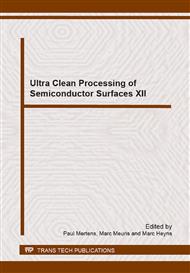p.32
p.36
p.40
p.47
p.52
p.56
p.59
p.63
p.68
Surface Chemistry of GaAs(100) and InAs(100) Etching with Tartaric Acid
Abstract:
Incorporating substrates with higher charge mobilities than Si and Ge in metal-oxide-semiconductor field-effect transistors (MOSFETs) would extend the scaling of this device architecture. III-V semiconductors are candidates, and etching and passivation processes are needed that are selective and yield smooth surfaces. The (100) face of III-V compounds contains both electron-deficient group III (Ga, In) atoms and electron-rich group V (P, As, Sb) atoms. Etching InP(100) in a mixture of HCl and H2O2 chlorinates the In (group III) atom forming a soluble product [1,2], yet the P (group V) atom is more reactive and is depleted from the surface [3]. α-Hydroxy acids (lactic, citric, malic, and tartaric) have been shown to bind to the group III atom [3] and could promote more uniform etching. This paper compares the surface chemistry of GaAs and InAs after etching in HCl and H2O2 mixtures with and without tartaric acid.
Info:
Periodical:
Pages:
52-55
Citation:
Online since:
September 2014
Authors:
Price:
Сopyright:
© 2015 Trans Tech Publications Ltd. All Rights Reserved
Share:
Citation:


